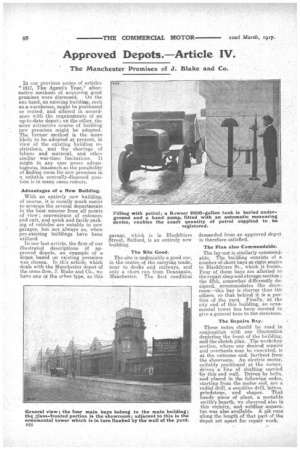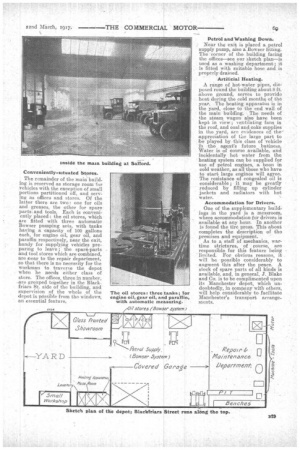Approved Depots. Article IV.
Page 4

Page 5

If you've noticed an error in this article please click here to report it so we can fix it.
The Manchester Premises of J. Blake and Co.
In oar previous series of articles "1917, The Agent's Year," alternative methods of acquiring good premises were discussed. On the one band, an existing building, such as a, warehouse, might be purchased or rented, and altered in accordance with the requirements of an up-to-date depot ;' on the other, the more attractive course of building uew premises might beadopted. The former method is the more likely to be adopted at present, in view of the existing building restrictions, and the shortage of labour and material, and other similar war-time limitations. It might in any case prove advantageous, inasmuch as the possibility of ,finding room for new premises in a suitable centrally-disposed position is in many cases remote.
Advantages of a New Building.
With an entirely new building, of course, it is usually much easier to arrange the several departments in the best manner from all points of view ; convenience of entrance and exit, and quick and facile parking of vehicles are notable in new • garages, but not always so, when pre-existing buildings have been utilized.
In our last article, the first of our illustrated descriptions of approved depots, an example of a depot. based on existing premises was chosen. In this article, which deals with the Manchester depot of the same firm, j. Blake and Co., we have one or the other type, asthis garage, which is in Blackfriars Street, Salford, is an entirely new building.
The Site Good.
The site is undeniably a good one, in the centre of the carrying trade, near to docks and railways, and only a short run from Deansgate, Manchester. The first condition demanded from an approved depot is therefore satisfied.
The Plan also Commendable.
• The lay-out is similarly commendable. The building consists of a number of short hays at right angles to Blaekfriars St., which it fronts. Four of these bays are allotted to the repair shopand storage section ; the fifth, somewhat differently designed, accommodates the showroom—this bay is shorter than Oen others, so that behind it is a portion of the yard. Finally, at the city end of this building, an ornamental tower has been erected to give a general tone to the structure.
The Repairs Bay.
These notes should be read in conjunctien with our illustration depleting the front of the building, and the sketch plan. The workshop section, where any desired impairs and overhauls may be executed, is at the extreme end, furthest from the showroom. An electric motor; suitably positioned at the corner, drives a line of shafting carried by this end wall. Driven by belts, and placed in the following order, starting from the motor end. are a radial drill, a sensitive drill, lathes, grindstone and shaper.. That handy piece of plant, a portable smith's hearth, we observed also in this vicinity, and welding apparatus, was also' available. A pit runs along the length of that Ina of the depot set apart for repair work.
The remainder of the main building is reserved as storage room for vehicles with the exception of „small portions partitioned off, and serving as offices and stores. Of the latter there are two : one for oils and greases, the other for spare parts and tools. Each is conveniently placed : the oil stores, which are fitted with three automatic Bowser pumping sets, with tanks having a capacity of 100 gallons each, for engine oil, gear oil, and paraffin respectively, near the exit, handy for supplying vehioles preparing to leave ; the sparA-parts and tool stores which are combined, are near to the repair department, so that there is no necessity for the workman to traverse the depot when he needs either class of store. The offices, three in number, -are grouped together in the Black-. friars St. side of the building, and supervision of the whole of the depot is possible from the, windows, an essential feature. Petrol and Washing Down.
Near the exit is placed a petrol supply pump, also a Bowser fitting. The corner of the building facing the offices—see our sketch plan—is used as a washing department ; it is fitted with suitable hose and is properly drained.
Artificial Heating, A range of hot-water pipes, disposed round the building about 8 ft. above ground, serves to provide heat during the cold months, of the year. The heating apparatus is in the yard, close to the end wall of the main building. The needs of the steam wagon also have been kept in view-; ventilating fans in the roof, and coal and coke supplies in the .yard, are evidences of, the appreciation of the large part to be played by this class of vehicle ih the agent's future business. Water is of course available, and incidentally hot water from the heating system can be supplied for use of petrol engines, a boon in cold weather, as all those who have to start large engines will agree. The resistance of congealed oil is considerable ; it may be greatly seduced by filling up cylinder jackets and radiators with hot water.
Accommodation for Drivers.
One of the supplementary buildings in the yard is a, messroom, where accommodation for drivers is available at any hour. In another is found the tire press. This about completes the description of the premises and equipment.
As to a staff of mechanics, W artime strictures, of course, are responsible for this feature being limited. For obvious reasons, it will be possible considerably to augment this after the peace. A stock of spare parts of all kinds is available, and, in general, J. Blake and Co. is to be complimented upon its Manchester depot, which undoubtedly, in company with others, will help considerably to facilitate Manchester's transport arrangements.




















